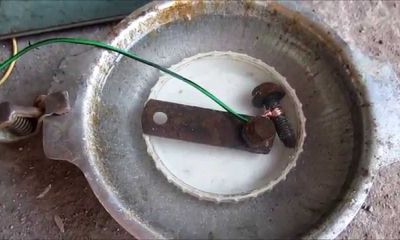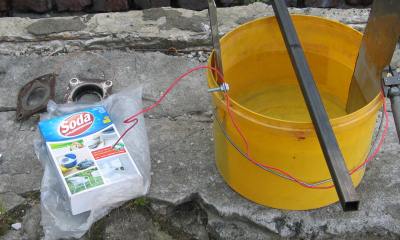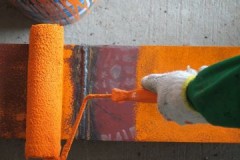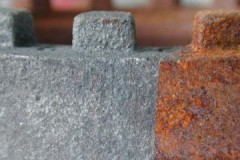Advantages, disadvantages and step-by-step instructions for removing rust by electrolysis
 Dealing with rust without damaging the metal surface is not an easy task.
Dealing with rust without damaging the metal surface is not an easy task.
The mechanical method of removing it leads to scratches on the product, and chemical reagents provoke oxidative processes, as a result of which the part will rust even more in the future.
A safe and relatively simple way to deal with rust is to remove it by electrolysis. Read about how effective this method is and how to correctly implement it in practice.
Content
Is the method effective?
Electrolysis really does help with rust. It is a mixture of iron oxides and hydroxides, which are formed when the metal comes into contact with water and oxygen.
If you do not delve into complex chemical processes, then we can say that the method allows you to reverse the oxidative reaction and restore previously damaged areas.
Correctly, this method of dealing with rust is not called electrolysis, but the electrogalvanic method. It is used not only in everyday life, for personal needs, but also for a more serious purpose, for example, in the restoration of archaeological finds.
Pros and cons of cleaning
 Electrolysis, as a method of dealing with rust, is absolutely safe. The electrolyte solution is not toxic, but it should not be consumed internally.
Electrolysis, as a method of dealing with rust, is absolutely safe. The electrolyte solution is not toxic, but it should not be consumed internally.
The emitted gases are non-toxic... Currents are used at low frequencies, so they cannot harm your health.
Another advantage of the method is that there is no risk of damaging the part. Even if you overexpose it in solution, nothing terrible will happen, the self-healing process will not be reversed because of this.
Compared to mechanical and chemical methods of rust removal, electrolysis has one very important advantage. This method does not affect "living metal", that is, one that has not yet undergone changes.
Abrasives, brushes, acids and other aggressive methods of exposure inevitably lead to the fact that some of the unspoiled metal will be removed, but this does not happen during electrolysis.
In addition, you will have to spend some time not only on preparatory activities, but also on the cleaning itself.
Rules for removing plaque at home
To remove rust from the metal surface by electrolysis, will be required:
 a plastic container of a suitable size, such as a bucket or basin;
a plastic container of a suitable size, such as a bucket or basin;- a steel or stainless plate that will act as an electrode - it is better to give preference to stainless steel, since it will last much longer than ordinary metal, it is good if the plate completely surrounds the part to be cleaned around the perimeter;
- ordinary tap water;
- soda ash - it is sold in household chemistry departments, housewives use it to wash clothes;
- battery charger.
To prepare the solution, you will need 3 water and 1 teaspoon of soda. The procedure is as follows:
- The prepared solution is poured into the container.
- An electrode is lowered into it.
- The part that needs to be cleaned is immersed in the solution. This is done so that it does not touch the electrode.
- Connect the power supply. The polarity must be strictly observed. The electrode should be connected to the positive "+" conductor, and the object to be cleaned with a negative "-". Contact with details should be good.
- After completing all the preparatory manipulations, power is turned on. If the charger is equipped with an ammeter, you can see how the system began to pass current.
- After a short time, bubbles will appear on the part. This is completely normal and indicates that the cleaning process has started.
- The duration of the procedure depends on a number of factors. What matters is the size of the workpiece and electrode, as well as the area of rust. Periodically, the system must be turned off, removed from the solution and inspected. The average cleaning time is 5-6 hours. If the object is covered with a very thick layer of plaque, you can leave it soak overnight.
- When the cleaning process is completed, the part is removed, washed under running water and inspected. If small areas of rust remain on the product, they can be cleaned off with a plastic scraper.
Helpful information
To make the process of removing rust from metal by electrolysis as successful as possible, the following tips should be taken into account:
 The part needs to be processed only in a plastic container. Metal buckets or basins are not suitable for this purpose. Their use is fraught with the risk of short circuits or holes in them.
The part needs to be processed only in a plastic container. Metal buckets or basins are not suitable for this purpose. Their use is fraught with the risk of short circuits or holes in them.- If there is pitting corrosion on the product, do not attempt to remove it by electrolysis. The electrolyte is unable to penetrate into the thickness of the metal.
- No special disposal measures need to be taken after processing is complete. The solution is simply poured into the sewer, this will not cause any harm to the environment.
Related videos
The video will tell you how to remove rust by electrolysis:
Conclusion
Electrolysis helps to quickly and safely get rid of rust marks. This method is easy to use, does not harm the product, unlike chemical or mechanical cleaning. With a battery and a suitable capacity, it will cost almost nothing. You will have to spend only on caustic soda.



